BeoRemote One
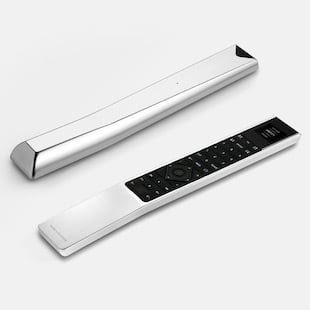

The casing is milled from a single block of Aluminium then anodised (in various finishes and colours) and the main workings of the controller (including the batteries) are slid into place along the centre of the casing. Being soft aluminium, these remotes can very easily pick up dents and scratches – unlike the much tougher and heavier Beo4, but if it’s elegance you’re looking for, the BeoRemote One certainly ticks the boxes.
The bright LED style display is clear and easy to read, and buttons are simple and intuitive – but the lack of any backlighting can make it frustrating to use in low light or darkness!
The BeoRemote One was originally IR (infra-red) only, but the second generation heralded the new Bluetooth command as the added standard way of communicating with products.
The standard colour was the polished and anodised aluminium, with a ‘Silk’ option also available which had a satin look to it. Bang & Olufsen released a Limited Edition ’90’ housing in Rose Gold to mark their 90th Anniversary, which are quite rare, but not to everyone’s taste!
Dimensions W x H x D 33 x 243 x 16 mm
Weight 144 g
Dimensions W x H x D, in packaging 295 x 50 x 122 mm
Weight, in packaging 224 g
Specifications
Materials Aluminium, plastics
Battery 2 pcs. LR03
IR range 455 KHz
Bluetooth Bluetooth IEEE 802.15.1, Class 2
Finish Silver, Silk
Display OLED – Monochrome, 1.3″ aspect ratio 1:1 with 128 x 128
Available documents are listed, if none are listed then please reach out to see if we have them.
Please let us know
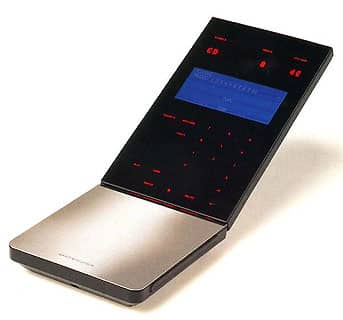
Beolink 7000, designed by David Lewis was, undoubtedly, one of the most beautiful and advanced remote control units ever made. Its completely new, radical design, with hardened glass and anodised aluminium surfaces enclosing sensi-touch panels and display menus, provided a unique interactive dialogue between the user and Bang & Olufsen’s audio and video systems.
The interactive nature of Beolink 7000 came into play as soon as you chose a function. Prompts or questions appeared on the screen to gently guide you through every stage of an operation. Beolink 7000 needed just a gentle touch of your hand to light up and literally, rise towards you, confirming its status as the world’s most advanced control unit. A simple touch on the electronically-sensitive metal front ‘woke up’ the unit and awaited your instructions.
Beolink 7000’s two-way infra-red data transfer capability could be used with every one of the latest (1991) audio and video systems. Its display panel provided two main areas of information. The top section provided data about the products and their functions. It told you which source was playing and offered the menu of functions for you to choose from. The lower section, with its combination of sensi-touch panels and displays allowed you to activate your chosen functions.
Beolink 7000 on its purpose-built wall stand incorporating mains charger to ensure that it was ready for operation at all times
A series of visual prompts guided the user through every stage of the operation with Beolink 7000 finally giving visual confirmation that your instructions had been carried out. Battery-operated for total freedom of use anywhere in the house, Beolink 7000 came with a stylish table-top recharging unit. And of course, being Bang & Olufsen, the terminal could be operated even when it was being recharged. As an alternative, Beolink 7000 could be placed high up on its purpose-designed stand next to your own armchair. The stand was adjustable for height and placed the unit at an angle slightly away from the vertical for optimum ease of operation.
This tall stand also contained a recharging unit to ensure that Beolink 7000 was fully operational at all times.
Beolink 7000 was the ideal terminal for anyone who had, or planned to have, Bang & Olufsen audio video systems linked to different rooms in the house through the Beolink® round-the-house system.
Features: Beolink 7000 was the ultimate in remote control units, its interactive nature making it ideally suited for the more complex operations of Bang & Olufsen’s systems of the early 1990’s, particularly when both audio and video systems were installed. Beosystem 6500 was designed for infra-red operation and only the Beolink 7000 terminal could operate all of its functions. Beolink 7000 was also recommended for rooms equipped with link systems. Additional speakers and an extra TV set extended the use and control of all available Bang & Olufsen sources to any room in the house. By working as part of a local Control System in a secondary room, Beolink 7000 extended the use and control of all available audio, video and light control sources. It could be attached to the wall-mounted unit where it gave a constant display and automatically recharged the terminal even when in use.
Other infra-red remote controls at the time that Beolink 7000 was available were the Beolink 1000 and Beolink 5000 terminals. The later versions of Beolink 7000 were fitted with RDS display as standard (see model Types below) which allowed you to view details of the radio channel to which you were listening. This however, would only function correctly when used with Beomaster 7000.
Dimensions: 110 x 22 x 300mm
Weight: 925g
Available documents are listed, if none are listed then please reach out to see if we have them.
Please let us know
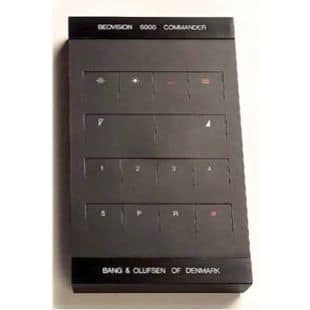
Please let us know
Available documents are listed, if none are listed then please reach out to see if we have them.
Please let us know
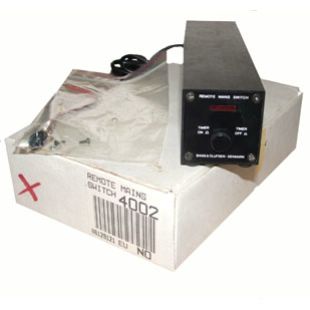
Please let us know
Available documents are listed, if none are listed then please reach out to see if we have them.
Please let us know

Beolink 1000 was Bang & Olufsen’s entry remote control terminal, released in 1986. Its bigger brothers were the two-way Beolink 5000 and Beolink 7000 terminals. It originally came in a number of guises: released in 1987 was Terminal A, followed by Terminal V and then Terminal AV. Their purpose was to control the audio section of various hi-fis (Terminal A); the video sections (Terminal V) and combined functions (Terminal AV).
Beolink 1000 won the ID Award in 1986.
Beomaster 2400’s new element was the Commander – the remote control – which no High-Fidelity producer had even dreamed of making before. In America, however, remote- controlled TVs had already become a reality and in Europe, the first TV commanders, with a plethora of buttons, had turned up in Germany.
Bang & Olufsen’s idea was not to supply remote controls for its systems, it was to provide the user with easier operation – to put the entire selection of sound and picture in users’ hands. Although today, this is perhaps self-evident, this was not the case at the time. Nobody had so far dared to pursue such an obvious concept. It did not take long for the idea to take root. Soon afterwards, all Bang & Olufsen’s systems enabled the user to operate the system from a commander.
The Bang & Olufsen Idea Group insisted that users should be able to operate the commander with one finger on one hand, the thumb. This was vastly different from the commanders manufactured by other producers where the many buttons meant that the user had to hold the commander in one hand, the manual in another while the index finger of the third hand pressed the button selected by the eye.
The concept was dubbed ‘the feel commander’. This meant that the TV could be operated by the thumb on one hand – almost as if the user was feeling his way through a new type of Braille, allowing the eye to concentrate on the essential, the picture.
The culmination of the development of the idea of a ‘total commander’ came in 1985 when David Lewis designed a Beolink terminal where the user, without using his eyes, could control picture, sound and light by applying a slight pressure of the thumb. Incredibly, it could be used in all the rooms of a house. This later system, known as Beolink®, eventually incorporated most of Bang & Olufsen’s audio and video products.
The Beolink 1000 family of remote controls is made up of four unique products; all similar in appearance, but each was brought out at a different time, for a variety of differing functions. First there was the Audio Terminal (or ‘A Terminal’). This was then followed by both the ‘Video Terminal’ (used by Beovisions LX2800 and LX2500) and then the ‘AV terminal’. Lastly was the Beolink 1000 as we recognise it today. Both of these latter Terminals are shown above.
The Audio and Video Terminals are similar in appearance to each other. However, they both accommodate different sets of buttons. With both these controls the bottom plate is stamped to differentiate them as either an Audio or Video Terminal. Size-wise, both Terminals are around 1,5cm shorter than a (current) Beolink 1000 Terminal.
Beolink 1000 Mk III was the last model produced and does not include a ‘turn’ button. To turn over the tape of your Beocord cassette deck, press SHIFT + SOUND.
In order to access ‘Balance’ press SOUND twice and then use the volume up and down to adjust.
To alter ‘Treble’, press SOUND three times and adjust in the same manner; for ‘Bass’ press SOUND four times.
To save your new settings, press SOUND and then STORE.
In comparison, the AV terminal is about 1cm longer than a Beolink 1000. The AV terminal could operate both audio and video and again was released before Beolink 1000. All three Terminals were black and dark grey coloured.
With Beolink 1000 (introduced in 1986), there have been six models. Beolink 1000 Mk 1 and 2 were also black and dark grey. The Mk 1 version would not work with light controllers such as LC1. However, Mk2 could, by simply pressing SHIFT + LINK more>>
Since its introduction in 1986, the Beolink 1000 family of remote controls has been able to control all subsequent Bang & Olufsen products – both audio and video. Beo4 is a direct descendant of these remote controls, together with its (former) smaller brother, Beo1.
Most infra-red remote controls work on a 40KHz carrier. Only Bang & Olufsen and a handful of Sony and Kenwood products use 455KHz as the carrier frequency. This more powerful frequency allows the Terminals to command products from a greater distance and often, it is not a requirement to ‘fire’ them directly at the items’ sensors.
Batteries: 3 x AA
Weight with batteries: 275g
Dimensions: 23,3 x 4,1 x 1,5cm
Available documents are listed, if none are listed then please reach out to see if we have them.
Please let us know
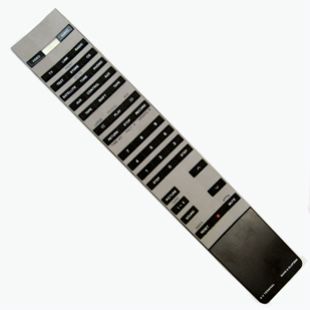
Beolink 1000 was Bang & Olufsen’s entry remote control terminal, released in 1986. Its bigger brothers were the two-way Beolink 5000 and Beolink 7000 terminals. It originally came in a number of guises: released in 1987 was Terminal A, followed by Terminal V and then Terminal AV. Their purpose was to control the audio section of various hi-fis (Terminal A); the video sections (Terminal V) and combined functions (Terminal AV).
From the Commander to the Beolink 1000 – a leap in ideas
Beomaster 2400’s new element was the Commander – the remote control – which no High-Fidelity producer had even dreamed of making before. In America, however, remote- controlled TVs had already become a reality and in Europe, the first TV commanders, with a plethora of buttons, had turned up in Germany.
Bang & Olufsen’s idea was not to supply remote controls for its systems, it was to provide the user with easier operation – to put the entire selection of sound and picture in users’ hands. Although today, this is perhaps self-evident, this was not the case at the time. Nobody had so far dared to pursue such an obvious concept.
It did not take long for the idea to take root. Soon afterwards, all Bang & Olufsen’s systems enabled the user to operate the system from a commander.
The Bang & Olufsen Idea Group insisted that users should be able to operate the commander with one finger on one hand, the thumb. This was vastly different from the commanders manufactured by other producers where the many buttons meant that the user had to hold the commander in one hand, the manual in another while the index finger of the third hand pressed the button selected by the eye.
The concept was dubbed ‘the feel commander’. This meant that the TV could be operated by the thumb on one hand – almost as if the user was feeling his way through a new type of Braille, allowing the eye to concentrate on the essential, the picture.
The culmination of the development of the idea of a ‘total commander’ came in 1985 when David Lewis designed a Beolink terminal where the user, without using his eyes, could control picture, sound and light by applying a slight pressure of the thumb. Incredibly, it could be used in all the rooms of a house. This later system, known as Beolink®, eventually incorporated most of Bang & Olufsen’s audio and video products.
The Beolink 1000 family of remote controls is made up of four unique products; all similar in appearance, but each was brought out at a different time, for a variety of differing functions. First there was the Audio Terminal (or ‘Terminal A’). This was then followed by both the ‘Terminal V’ (used by Beovisions LX2800 and LX2500) and then the ‘Terminal AV’. Lastly was the Beolink 1000 as we recognise it today. Both of these latter Terminals are shown above.
The Audio and Video Terminals are similar in appearance to each other. However, they both accommodate different sets of buttons. With both these controls the bottom plate is stamped to differentiate them as either an Audio or Video Terminal. Size-wise, both Terminals are around 1,5cm shorter than a (current) Beolink 1000 Terminal.
Beolink 1000 Mk III was the last model produced and does not include a ‘turn’ button. To turn over the tape of your Beocord cassette deck, press SHIFT + SOUND.
In order to access ‘Balance’ press SOUND twice and then use the volume up and down to adjust.
To alter ‘Treble’, press SOUND three times and adjust in the same manner; for ‘Bass’ press SOUND four times.
To save your new settings, press SOUND and then STORE.
In comparison, the Terminal AV is about 1cm longer than a Beolink 1000. The Terminal AV could operate both audio and video and again was released before Beolink 1000. All three Terminals were black and dark grey coloured.
With Beolink 1000 (introduced in 1986), there have been six models. Beolink 1000 Mk 1 and 2 were also black and dark grey. The Mk 1 version would not work with light controllers such as LC1. However, Mk2 could, by simply pressing SHIFT + LINK more>>
Since its introduction in 1986, the Beolink 1000 family of remote controls has been able to control all subsequent Bang & Olufsen products – both audio and video. Beo4 is a direct descendant of these remote controls, together with its (former) smaller brother, Beo1.
Most infra-red remote controls work on a 40KHz carrier. Only Bang & Olufsen and a handful of Sony and Kenwood products use 455KHz as the carrier frequency. This more powerful frequency allows the Terminals to command products from a greater distance and often, it is not a requirement to ‘fire’ them directly at the items’ sensors.
Please let us know
Available documents are listed, if none are listed then please reach out to see if we have them.
Please let us know
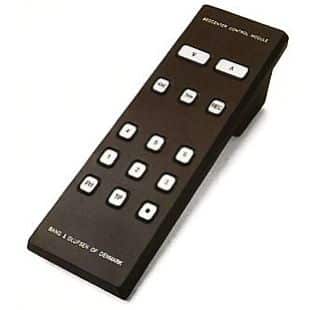
Please let us know
Available documents are listed, if none are listed then please reach out to see if we have them.
Please let us know
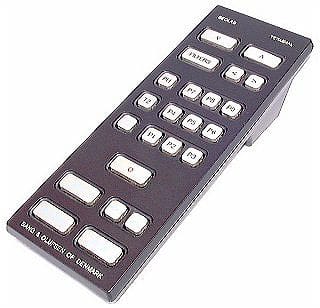
Please let us know
Available documents are listed, if none are listed then please reach out to see if we have them.
Please let us know
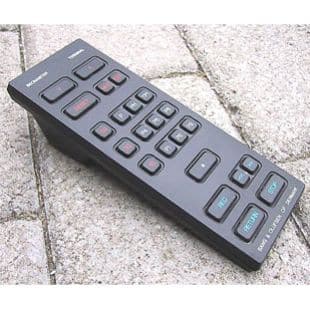
Please let us know
Available documents are listed, if none are listed then please reach out to see if we have them.
Please let us know
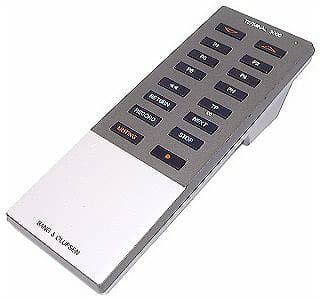
An infra red controller for use with the Beosystem 3000, the Terminal 3000 was a simple one way remote allowing selection of source and volume and a limited amount of control of the sources. This era of controls tended to be specific to one particular device ad were superseded by the Beolink 1000 type remote which provided a common remote for all products.
Dimensions: 6 x 4 x 17cm
Radio programmes: 5 FM
Other programmes: PH-TP (CD)
Beocord Controls: 6
Beogram Controls: 1
Compact Disc Controls: 1 (TP)
Volume Control: Yes
Available documents are listed, if none are listed then please reach out to see if we have them.
Please let us know